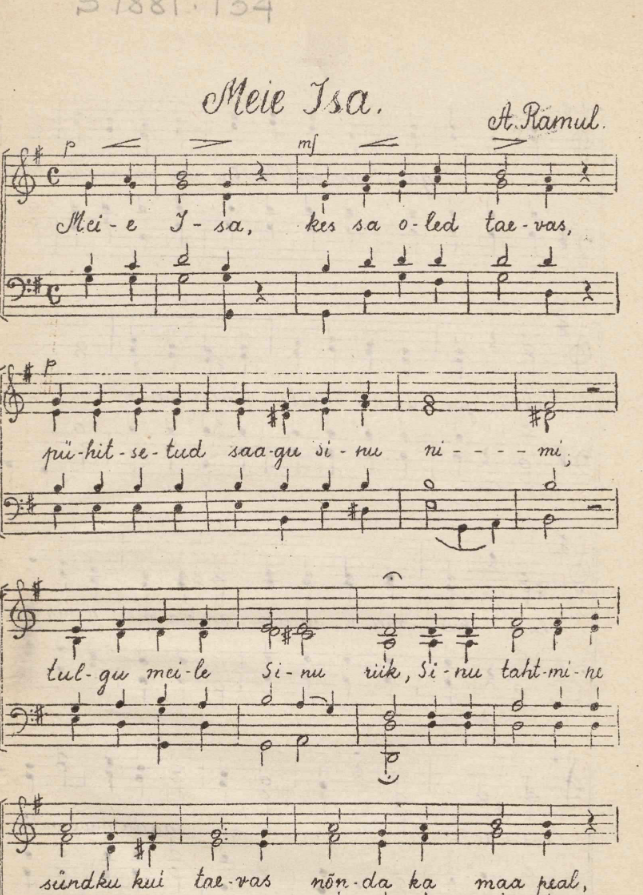Father Andrei Ramul (1842-1926)
Bringing Music to the People
Father Andrei Ramul
Father Andrei Ramul was born on 25 March 1842, the son of a farmer in Laius-Tähkvere municipality, Tartu county. After attending both a village and Orthodox parish school, he entered the Riga ecclesiastical seminary at the age of 15. The seminary was one of the few institutions of professional secondary education in Livland province at the time to offer tuition to young men from peasant families. Some pupils started there and then continued their education elsewhere, such as universities deeper in the Russian Empire. Others set their hearts on becoming clergymen after graduating from the seminary. Two years of study guaranteed a place, and thus a wage, as a sacristan-school teacher in a local Orthodox parish school. Andrei was primarily interested in religious issues and desired to become a priest. As a seminary student, he improved his skills in church music and earned a living as a substitute choirmaster.
In 1869, Andrei married Elisaveta Pavlovna: their family was blessed with seven children. After graduation from the seminary in the same year, Andrei was ordained a deacon and then priest by Bishop Veniamin (Karelin) of Riga. He was appointed to the parish of Lümanda in Saaremaa, where he served as a priest until 1891.
The Lümanda Orthodox church
Father Andrei's first spiritual poems and pieces of music were written while he was in Lümanda. He also wrote the polemical pamphlet What is the Difference Between Orthodoxy and the Teachings of Lutheran Church (1890) and compiled a 12-volume biography of the saints, which was published at the expense of the Russian-Estonian Brotherhood of St Nicholas in Kuressaare in between 1884 and 1889. While serving in Lümanda, Father Andrei, like other Estonian Orthodox clergy, employed congregational singing. As a result of his successful activities, he was commissioned by the Riga Orthodox consistory to compile a collection of basic church music. The first product of this was task was Methods of the Orthodox Church Singing for Schools I (Riga, 1885), which remained the only study book for church singers in Estonian-speaking schools of the Riga Diocese for twenty years after its publication.
The year 1879 witnessed regular services held in Estonian in the cathedral church of the Transfiguration in Tallinn. As of 1880, there were 173 Estonians in this parish: ten years later, this number had risen to 1,052. The Juuru, Angerja, and Aruküla parishes were created for local Estonian Orthodox near Tallinn. In 1890, Karp Tiisik, the priest of the Tallinn cathedral of the Transfiguration, submitted a petition to the dean to open an independent parish for the Estonian faithful. Consequently, on 28 July 1891, an Estonian-speaking parish of the Holy Image of Our Lady of Vladimir was created by decree of the Holy Synod. They began to hold services in the basement of the church adjacent to the cathedral. The parish clergy consisted of one priest, one deacon, and two sacristan-school teachers. Father Andrei was invited to work here, taking charge of the congregation from 1 January 1892. It quickly grew to several thousand people. There was so much life and activity that the small church could no longer accommodate all the participants in the services.
Interior of the Tallinn church of the Transfiguration
With the completion and consecration of Aleksandro-Nevskii cathedral in Tallinn on 30 April 1900, the Russian-speaking congregation of the old Transfiguration cathedral moved there: Father Andrei in turn transferred to the abandoned temple with his Estonian congregation. Much work awaited them: new icons, vestments, liturgical paraphernalia, and books had to be acquired. Equally, religious services, missionary classes, catechetical activities, a church choir, parish schools, and regular pastoral care for the Estonian Orthodox in Viimsi, Kolgaranna, and Muraste had to be organised. Father Andrei remained at the church of the Transfiguration in Tallinn until 1917.
Copy of Father Andrei’s song “Our Father”
Throughout all of these moves, Father Andrei continued with his creative work. Besides the aforementioned texts, he also penned collections of liturgical songs. One, Spiritual Songs, Psalms, and Chants (Tallinn, 1896), caused big waves, sparking a lively discussion on the extent to which non-liturgical hymns created by Estonian Orthodox clergy could be used in the Orthodox Church. Conservative priests saw this as apostasy and excessive modernism, but younger and more nationally-minded clergymen saw it as an opportunity to bring Orthodox songs closer to the hearts of the Estonian people. Controversy over church music sapped Father Andrei’s will to work. Only in 1905, when greater attention was paid to the Estonian- and Latvian-speaking Orthodox of Riga diocese, was another song collection published. This made Father Andrei the first promoter of congregational singing and rhyming psalmody in the Estonian Orthodox Church. Among his Estonian congregational hymn books, some pieces were translations while others were original, such as the songs “Our Father”, “The Grace of Peace”, and “The Song of the Cherubs”: these remain well-known and are still in use in the Estonian Apostolic Orthodox Church.
Father Andrei served the Estonian-speaking congregation of the Transfiguration in Tallinn until old age. By 1926, the congregation had grown to 7,000 members. The old priest passed away on 28 October 1926 in Tallinn and was buried Aleksandri cemetery next to the grave of his wife Elisaveta. Father Andrei’s contribution to the Estonian Orthodox Church as a clergyman, a compiler of the lives of saints, and a promoter of Orthodox songs was invaluable. Between 1884 and 1905, he published a total of 13 works. Of his seven children, one is of particular note: Konstantin Ramul (1879-1975) went on to become a famous psychologist, establishing the Department of Psychology at the University of Tartu.
AUTHOR
Father Andrei Sõtšov



